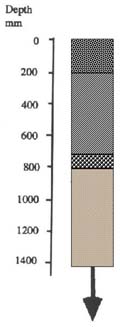Dalmore Clay
Symbol: Da
Geology - Recent lacustrine (lake or swamp) deposits.
Landform - Lacustrine plain.
Soils - This soil, named by Goudie (1942), occurs in the vicinity of the Cardinia Drain. The surface soil is about 200 mm deep and is a black friable clay. This passes into a black or dark grey plastic clay. At about 700 mm, a thin layer (about 100 mm) of black peaty clay overlies a grey impervious clay. Soil pit site information for two Dalmore clay soil profiles can be found for Sites GP23 and GP25. These soils are referred to as Self-mulching, Black VERTOSOLS using the Australian Soil Classification (Isbell 1996).
Typical profile of Dalmore Clay
 | 0 - 200 mm. Black or very dark grey friable clay, clear transition to: 200 - 700 mm approx. Black or very dark grey plastic heavy clay, clear transition to: 700 - 800 mm. Black peaty clay or clayey decomposing peat. Abrupt transition to: 800 mm continuing to 1.5 m +. Grey impervious clay with yellow-brown mottles. |
Dalmore clay is highly sought after for market gardening as it not only better drained internally than Dalmore clay (non-peaty), but it generally has a more friable surface.
There is evidence that soil compaction may occur as a result of excessive tillage or use of heavy machinery when the soil is wetter than the plastic limit. This will restrict root penetration into the subsoil and increase waterlogging during the wetter months.
Dalmore clay and Koo-Wee-Rup peaty clay
Symbol: Da:Ko
This mapping unit occurs in one area only, ie. west of Tooradin. It is a previous estuarine swamp and has variable peaty layers within the clayey profile.


